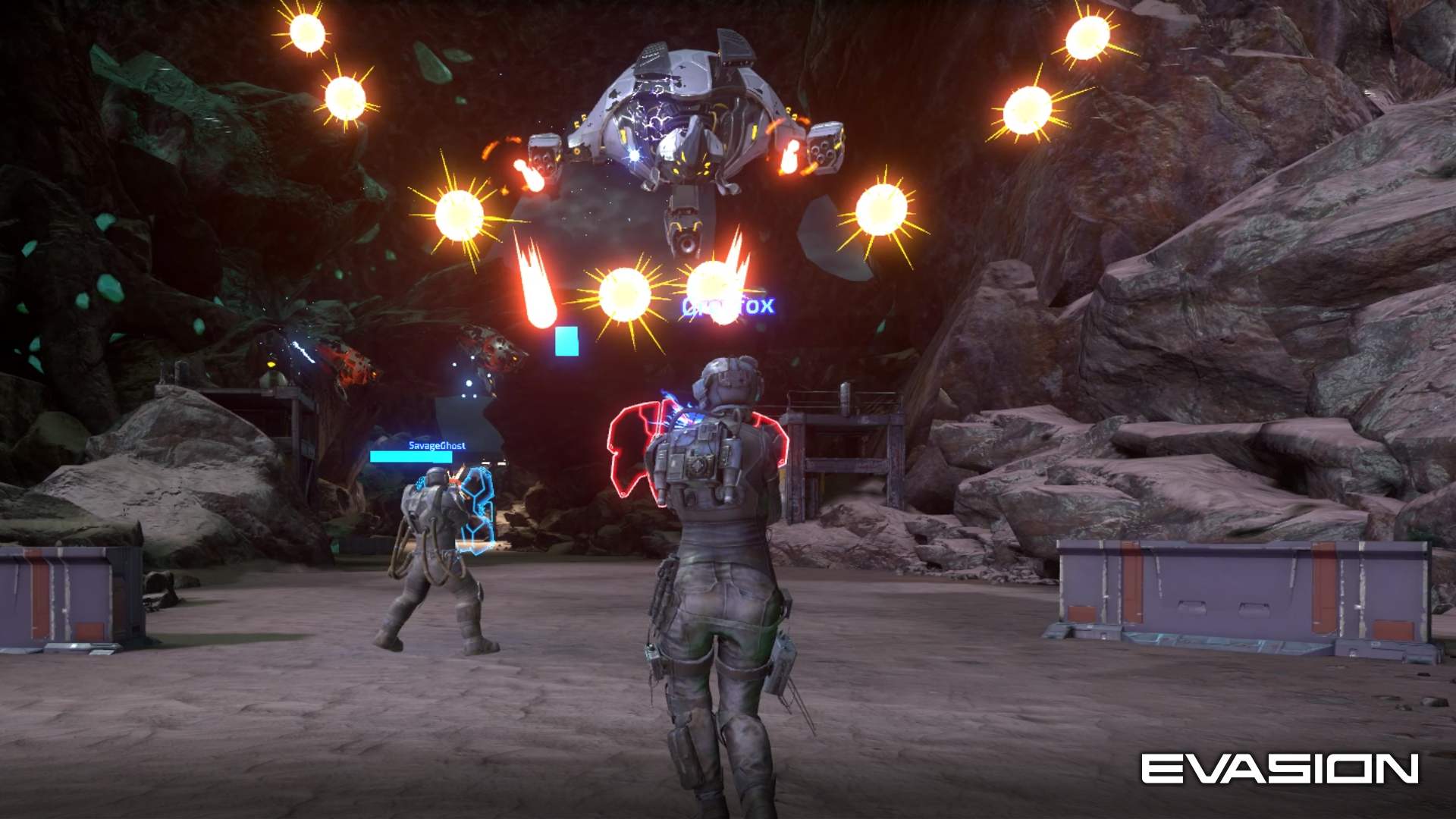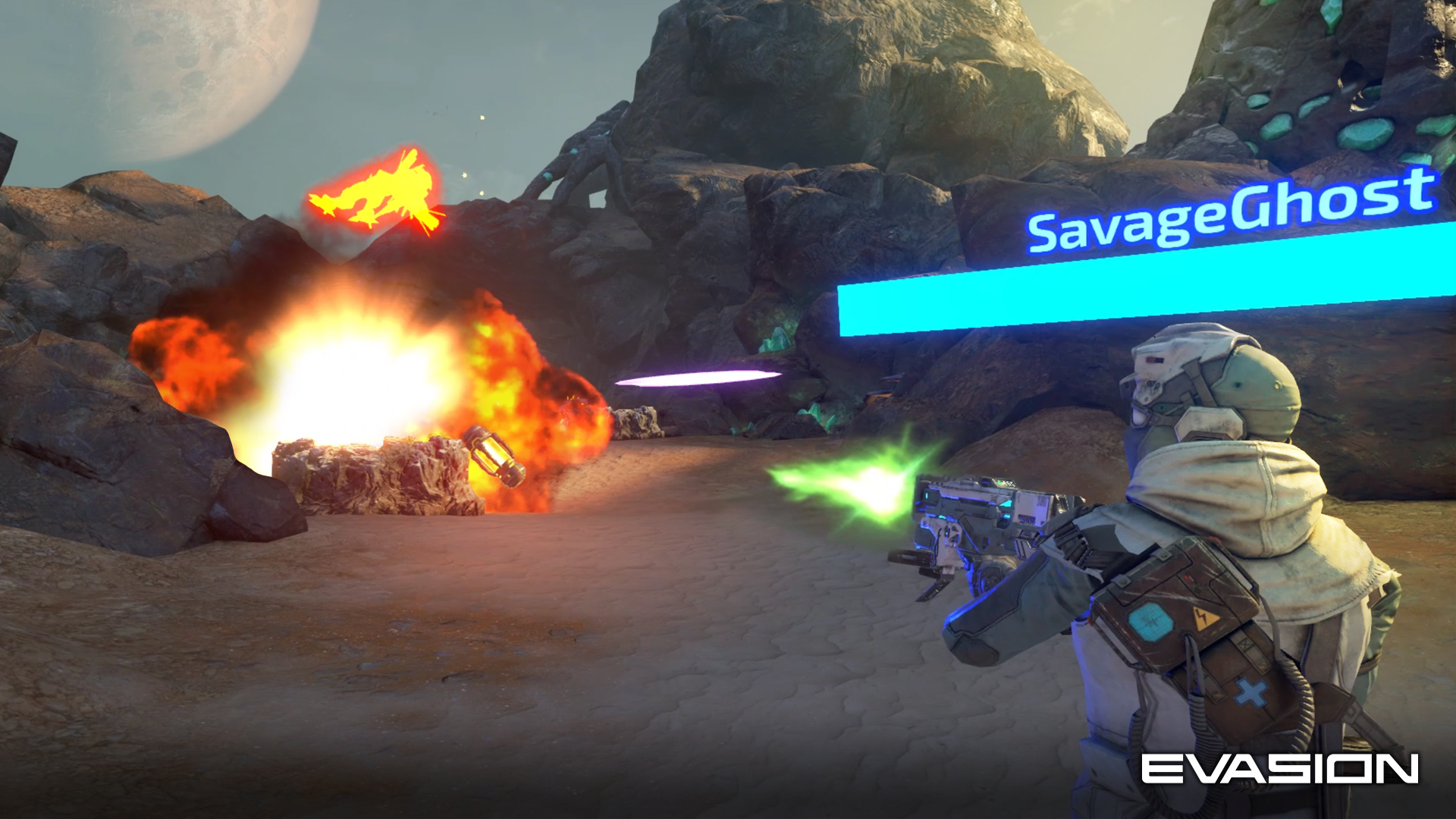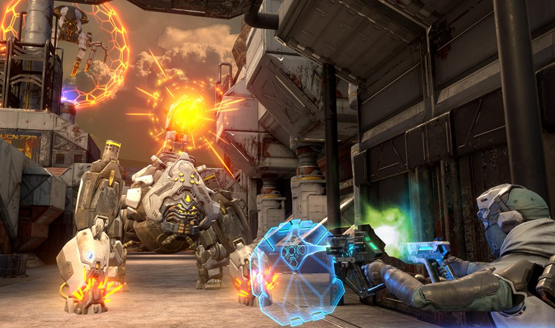
Virtual reality has been widely available for living room consumption for more than two years now. That time has been a whirlwind of new releases, fascinating experiences, and questions about the future of the platform. While it’s definitely been quite a leap forward in technology, VR isn’t without its own share of difficulties, both for developers and the players. Despite those difficulties, Archiact has continued to push development in the medium forward, both through publishing and development of virutal reality games.
Their latest game, the bullet-hell co-op first-person shooter Evasion, recently released. Somewhere in all of the craziness that is launching a new game, Archiact found an opportunity to talk to us about their company’s focus on virtual reality, developing games for VR, and what the future of gaming in a headset might hold.
PSLS: Tell us a little bit about Archiact! Evasion is your big tentpole release, but you’ve got a lot of experience with publishing and developing a bunch of smaller VR games. How many people are at Archiact right now working on your various projects and when did you decide to make a shift from “bite-sized experiences” to “AAA online VR shooter?”
Jennifer Dowding: In July of 2016, we started working on Project Elektron, which would eventually become Evasion. It grew out of a multiplayer shooter we were developing in UE4 for arcades in China. We saw so much potential for a great VR action shooter, so we started building a demo that we could show off externally to potential partners. The demo was very well received at GDC and at that point the now called “AAA” team was full throttle on creating Evasion. We wanted to leave those “bite-sized experiences” behind.
PSLS: VR seems like a tough space to be in right now, with a fairly limited audience compared to traditional console games. What drew you to this space and what keeps you trying to raise the bar for VR game development?
Dowding: Archiact has always been a dedicated VR (& now AR) studio. Our goals are to craft cinematic and memorable experiences that take full advantage of the latest technologies. On a base level, we know that VR gamers want the very best and are careful with what they buy, we want to make sure our games are among those that they want to invest in over and over again.
PSLS: Virtual reality games aren’t just an evolution of traditional gaming, but almost another facet of control and immersion. It’s not a replacement. It’s a supplement. What things within 2D gaming do you look towards for inspirations, and what things does 2D gaming have that you want to avoid with VR?
Dowding: One of the design goals of Evasion is to get players into the action as soon as possible. We wanted it to be a pickup and play for anyone, since VR allows you to just point and shoot, so we wanted to make sure all of our controls felt easy and intuitive. We didn’t want them to get in the way of the gameplay, especially when you’re distracted by incoming bullets and evading enemies. Therefore our menu system and tutorial elements are relatively familiar, to keep them quick, simple and intuitive—we really saw the benefits when demoing of a quick menu system that allows players to do what they need, like change locomotion settings or volume and jump right back into the action.
PSLS: How much of your time spent developing a VR game is spent inside the headset? Are there ever ideas that seem great on a flat screen but don’t end up translating as well once the headset is on (or vice versa, are there some ideas you didn’t think were that impressive while developing on a 2D screen, but really took off once you experienced it in the headset)?
Dowding: Yes, this is constantly the case. Developing for VR requires prototypes you can “jump” into (literally) and for us the iteration never stopped. The team’s designs would often need to adapt based on what felt good in VR and our assumptions were often wrong. I remember we fumbled with a “pedestal” that we wanted to lift players with, but with different room scale sizes, it became much more complicated as players could just walk off the edge. The VR space is much more like the real world, so designs for theme parks & hospitals we’re sometimes inspiring, as much as traditional UI design for games.
PSLS: Virtual reality was the talk of gaming during the year that it launched. A lot of that chatter has quieted down significantly, save for the occasional big release here or there, such as Polyarc’s Moss. Where do you see headset gaming going in the future? Has virtual reality sung its song, or is there still a place for VR gaming?
Dowding: VR is a whole new medium, I wouldn’t count it out just yet. There will always be a place for incredibly cinematic immersive experiences. VR is still totally mind-blowing for people who try it for the first time and it will only get better with new technology and the passion of great teams making epic experiences. It may not look the way we expected, but it’s definitely still growing, and it may take a few years for teams to develop their works. Evasion took over 2 years and that is what it takes to make the games people love. PlayStation has been delighting players for years and the games have grown so much, I think VR needs a little time. For now, we are super appreciative of the people ahead of the game who are in on the ground floor. They will be the ones helping to define the future of this medium—both the devs, the reviewers and the players!
PSLS: Tell us briefly about Evasion! Why should people be dusting off the old PSVR headset to play your online co-op bullet-hell sci-fi shooter? You consider this game a AAA VR release, correct?
Dowding: Evasion offers non-stop action from start to finish, and I can guarantee that it’s one of the most beautiful PlayStation VR games, especially for the PS Pro. One of the things we loved about VR was getting in there with a friend, a family member or a colleague, because you could experience the magic together. Also, people tend to be a lot sillier once they get into VR. We wanted to create the very best avatar system so you can look awesome and chat with your friends as you endure intense survival challenges. One of my best memories was demoing the game with two strangers who came out to say, “We survived this, and now we’re brothers!” It was exactly the kind of camaraderie we wanted to create and we’d love for you to experience it.
PSLS: If you wanted to convince people of the unique possibilities of virtual reality, aside from your own Evasion, which PSVR titles would you prop up as exemplary examples of the medium and what can be achieved with it?
Dowding: There’s an absolute abundance of outstanding VR titles for PSVR, so the great news for gamers is they are in for a great experience from day 1. Moss would be one my first recommendations since it’s an incredibly well made adventure that allows you to breath, take your time and really enjoy being immersed in the world around you. As a completely different approach to VR gaming that doesn’t rely on twitch mechanics, Moss is an amazing achievement. Terrific VR titles that will blow away expectations on PSVR also include Beat Saber, Creed: Rise to Glory, and Firewall: Zero Hour. You can’t go wrong with any of these games, after you’ve completed Evasion of course.

PSLS: Archiact is one of the standard bearers at the front of not only championing VR, but also developing a VR game on a much larger scale than most bite-sized experiences we’ve become accustomed to. How do you balance the large-scale experience with the potential for VR sickness and other concerns some players might have about playing for extended periods of time?
Dowding: All of the Evasion team are passionate about pushing VR forward as a gaming medium. Achieving a consistently high frame rate has been a major priority throughout Evasions’ development, as we know core gamers will definitely expect to play for longer play sessions. Our team all have different preferences for VR locomotion and play session length, so we’ve worked extra hard on making player comfort a major part of our daily playtesting routine. Evasion is super easy to pick up and play, so ensuring we sport a range of comfortable locomotion options with a high framerate was essential to get right from day one.
PSLS: What have been some of the biggest lessons you’ve learned during the development of Evasion? Were there any takeaways from the experience that you will not only take into your next game, but also want other VR developers to know as they explore the space as well?
Dowding: Trust your instincts when it comes to developing fun gameplay. Don’t be so quick to judge the experience until it’s had a level of polish and all the key components are in place.
Find some fun, core mechanics to use as the core gameplay, then build from there. Don’t start with a large feature list. And don’t be afraid to try things out and challenge industry perceptions of VR. There’s been a lot of people telling everyone what they can and can’t do in VR, but it’s better to take those as suggestions rather than rules.
PSLS: Evasion is available for multiple VR headsets. Was it challenging developing for more than one simultaneously? Are there any particular strengths or weaknesses that each headset has over the others, from a development perspective?
Dowding: Getting Evasion to feel great on each headset was a big priority, with the PSVR offering cool controller alternatives such as the Aim Controller. There was a huge effort from our team on customizing the gameplay for PC format versus PlayStation. One major example of tuning gameplay for each headset was found within the shield gameplay. PSVR gamers get to experience Evasion’s gunplay with the shield mounted directly on top of the weapon. On PC formats, the Vive and Oculus present a two handed control system with the weapon and shield on separate hands. Both have their own unique feel and flow to combat and we went through a lot of iteration to get a AAA gameplay feel across each headset.
PSLS: Evasion is a multiplayer game, which means servers, networks, matchmaking, and all the other fun unknowns that can come with online experiences. Is it notably different attempting to get those network play ducks in a row for a VR game than it is for a more traditional multiplayer experience?
Dowding: We found that our experience with traditional multiplayer game development was super instructive for Evasion’s networking framework. Thankfully, there’s not a huge difference between VR and non-VR games when it comes to networking, matchmaking and server setup. We are a co-op shooter so our matchmaking has a sharper focus than say, competitive FPS matchmaking where a range of skill ceiling variables come into play.
PSLS: How would you like to see the VR hardware develop in the future to better support you as a VR game developer? Do Sony, Oculus, and other VR headset manufacturers give you any notice on what might be changed or updated in future iterations of the headsets?
Dowding: VR is still very much in a transformative phase and we have a millions ideas on features and experiences we’d love to see integrated by our hardware partners. Enhancing player agency with wireless headsets, inside out tracking and wider cross-play opportunities are all areas we’re excited about in 2019.

PSLS: Any last words you’d like to send us off with about VR game development, the future of the medium, and Archiact’s place in it?
Dowding: We’ve seen a glimpse into the future of VR and it’s absolutely awesome. Now is definitely the time for gamers to jump into VR because of the sheer breadth and depth of AAA game experiences. Gaming is about immersion and being transported to fascinating new worlds, both aspects of VR that traditional gaming will always struggle to match. Archiact are big supporters of VR development, from local indie Game Jam initiatives here in Canada all the way through to solving the next big space planning and architectural challenges of tomorrow. There’s no limit to where VR can take us, and we’re thrilled to be playing a role in its development.
We’d like to thank Jennifer Dowding and Archiact for taking the time to talk to us about Evasion, game development, and virtual reality. Evasion is available now. Don’t miss our review and in-depth looks at each of Evasion’s character classes.
Evasion August 2018
-
Evasion Screenshot 1

-
Evasion Screenshot 2

-
Evasion Screenshot 3

-
Evasion Screenshot 4









